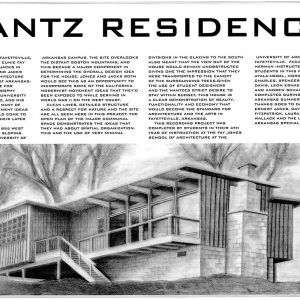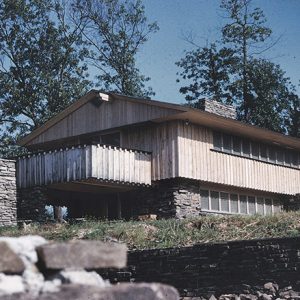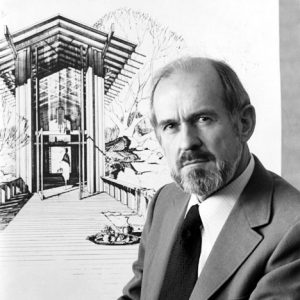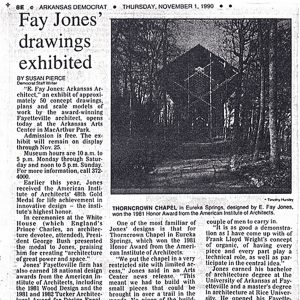calsfoundation@cals.org
Fay Jones (1921–2004)
aka: Euine Fay Jones
aka: E. Fay Jones
Fay Jones was an internationally known architect from Arkansas who won the American Institute of Architects’ highest honor, the AIA Gold Medal, in 1990. From his small studio in Fayetteville (Washington County), he practiced architecture from 1954 to 1998. He designed 218 projects, encompassing residential buildings, educational and commercial buildings, chapels, pavilions, and intricate metal structures. The most acclaimed of Jones’s buildings is Thorncrown Chapel in Eureka Springs (Carroll County). Of the 218 projects for which records exist, 129 projects were built; eighty-four were built in Arkansas.
Euine Fay Jones was born in Pine Bluff (Jefferson County) on January 31, 1921, to Euine Fay Jones and Candie Alston Jones. The family moved to El Dorado (Union County), where Jones grew up and where his father owned and operated The People’s Café for many years. Jones had two older sisters, both of whom died in childhood. Early in his career Jones used his full name, but Euine (pronounced “yu-on,” a Welsh form of John) was hard to pronounce and hard to spell. He decided to use only the initial E, and for most of his professional life he was known as E. Fay Jones. In 1990, Jones decided to drop the E and be known officially as Fay Jones, which is the name on the Gold Medal.
As a boy, Jones learned he had distinct talents for drawing and construction. He built tree houses and underground forts and “drew on everything.” In El Dorado, after seeing a film about Frank Lloyd Wright and his Johnson Wax Building, Jones came away determined to combine, as he said, “drawing and building.” When he enrolled at the University of Arkansas (UA) in Fayetteville in 1938, the only architecture classes offered were in the engineering department, so for two and a half years he studied civil engineering. He was a member of the Kappa Sigma fraternity.
When World War II began, Jones enlisted in the United States Navy. He attained the rank of lieutenant naval aviator and was a reconnaissance pilot in the Pacific. Before the war, in Little Rock (Pulaski County), Jones had met Mary Elizabeth Knox of Hot Springs (Garland County). Jones and “Gus,” as she is familiarly known, married while he was on leave in San Francisco on January 6, 1943. In 1945, Jones returned to Little Rock, where he worked as a draftsman for an architectural engineering firm. His talents were noticed, and he was encouraged to come back to the University of Arkansas in 1946 to enroll in the new architecture program started by John Williams. Gus and Fay Jones were by this time the parents of two daughters.
After graduating from UA in 1950, Jones was accepted into the graduate program at Rice University, where he finished his Master of Architecture degree in 1951. From 1951 to 1953, he held his first teaching job at the University of Oklahoma, working with the noted architect Bruce Goff. In 1953, Jones came back to Arkansas to begin his twin careers of teaching and practice. In 1966, he became the first chair of the architecture department, and in 1974, he was named the first dean of the new School of Architecture. He inspired and educated generations of Arkansas architects and lectured widely throughout the United States. In l985, the Association of Collegiate Schools of Architecture awarded him the title of ACSA Distinguished Professor.
Fay Jones first met his mentor, Frank Lloyd Wright, in 1949 at the AIA Annual Convention in Houston, where Wright was to receive the Gold Medal. They met again at the University of Oklahoma, and Wright invited Jones to visit his Arizona studio, Taliesin West, during Easter of 1953. The next summer, Jones was invited to become an apprentice at Taliesin East in Wisconsin. Both Jones and his wife became members of the Taliesin Fellowship, returning annually for the next ten years, primarily to Taliesin West. Wright’s most lasting influence on Jones would be in the application of the principles of organic architecture: simplicity of construction, use of native materials, attention to crafted details, and seamless integration of building to site. In his own work, Jones reached new and original architectural conclusions with the innovative vertical use of glass and a strict awareness of the role of interior and exterior spaces of light.
Beginning in the 1960s, Jones employed a number of young architects in his studio, and he assembled a team of local builders, woodworkers, and stonemasons who worked on most of the buildings. The firm received over twenty national design awards and its work has been published in major architectural magazines in the United States, Europe, and Japan. The AIA gave Honor Awards to Thorncrown Chapel, Pinecote Pavilion at the Crosby Arboretum in Picayune, Mississippi, and the Roy Reed House in Washington County. In 2000, the AIA recognized Thorncrown as the fourth most significant structure of the twentieth century. In 2006, Thorncrown was named to the AIA’s exclusive list of Twenty-five Year Award buildings. Jones’s personal achievements included winning a fellowship and two periods of independent study at the American Academy in Rome. In 2000, he was named by the AIA as “one of the ten most influential architects of the twentieth century.” He held honorary doctorates from Kansas State University, Hendrix College, Drury College, and the University of Arkansas.
Several of Jones’s buildings in Arkansas are on the National Register of Historic Places. These include Thorncrown Chapel, Fay Jones House, Shaheen-Goodfellow “Stonefower” Cottage in Cleburne County, Hantz House, Henley-Riley Historic District (composed of the Henley House and Riley House), Clark House, Faubus House in Huntsville (Madison County), and the Bella Vista Country Club. Other notable Jones properties in Arkansas include houses for members of the Sam Walton family in Benton County, the Pallone House in Pulaski County, the Alexander House in Washington County, and the Cooper Chapel in Bella Vista (Benton County). Jones often designed furniture, lighting fixtures, and other crafted pieces for his buildings.
Fay Jones died at his home in Fayetteville on August 30, 2004. He had suffered from Parkinson’s and heart disease but continued to enjoy family, friends, and the world of architecture. He took up sketching again and filled many notebooks with lyric drawings of natural objects and abstract shapes. Following a private cremation, a memorial service was held on September 29, 2004, at UA near the J. William Fulbright Memorial Peace Fountain, which was his last design. On April 4, 2009, the School of Architecture at UA was named in his honor.
For additional information:
Cottingham, Jan. “Architect Fay Jones.” Arkansas Times, February 9, 2001, pp. 12–14, 16.
Fay Jones Collection. Special Collections. University of Arkansas Libraries, Fayetteville, Arkansas. Finding aid online at https://libraries.uark.edu/specialcollections/manuscripts/fayjones/ (accessed July 11, 2023).
Ivy, Robert Adams, Jr. Fay Jones: The Architecture of Fay Jones, FAIA. Washington DC: American Institute of Architects Press, 1992.
Nichols, Cheryl, and Helen Barry. The Arkansas Designs of E. Fay Jones, 1956–1997. Little Rock: Arkansas Historic Preservation Program, Department of Arkansas Heritage, 1999.
“Outside the Pale”: The Architecture of Fay Jones. Fayetteville: University of Arkansas Press, 1999.
Reyes, Paul, ed. “Stressing the Light: the Style and Mind of the Great American Architect, E. Fay Jones.” Oxford American. Fall 2005, pp. 86–101.
Sacred Spaces: The Architecture of Fay Jones. DVD. Fayetteville: University of Arkansas Press, 2010.
Shannon, Jeff. Shadow Patterns: Reflections on Fay Jones and His Architecture. Fayetteville: University of Arkansas Press, 2017.
White, Mel. “The Master Builder: Fay Jones of Fayetteville Emerges as One of the World’s Leading Architects.” Arkansas Times, October 1983, pp. 52–65.
Williams, John. The Curious and the Beautiful: A Memoir History of the Architecture Program at the University of Arkansas. Fayetteville: University of Arkansas Press, 1985.
Ellen Compton
University of Arkansas Libraries
 Arts, Culture, and Entertainment
Arts, Culture, and Entertainment Divergent Prosperity and the Arc of Reform, 1968–2022
Divergent Prosperity and the Arc of Reform, 1968–2022 Cooper Chapel
Cooper Chapel  Cooper Chapel
Cooper Chapel  Hantz House
Hantz House  E. Fay and Gus Jones House
E. Fay and Gus Jones House  Fay Jones
Fay Jones  Fay Jones
Fay Jones  Fay Jones Drawings Article
Fay Jones Drawings Article  Thorncrown Chapel
Thorncrown Chapel  Greeting Frank Lloyd Wright
Greeting Frank Lloyd Wright 



Comments
No comments on this entry yet.